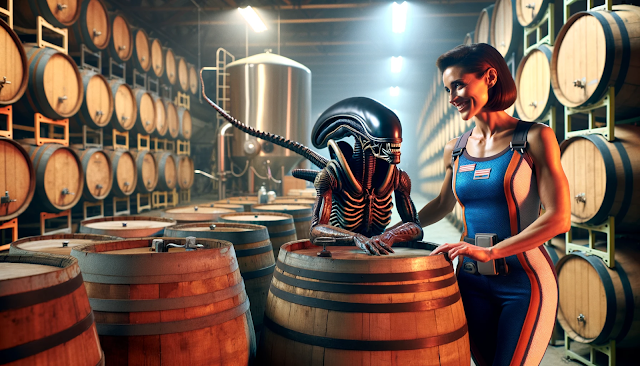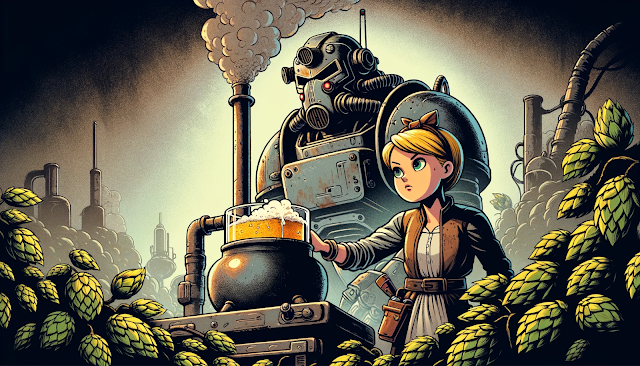When beer rests in oak barrels, especially those previously holding spirits or wine, subtle chemistry unfolds. Wood breathes life into the beer, gifting it smoky whispers, lush vanilla notes, and echoes of its former tenants—whether bourbon’s caramel warmth, sherry’s nutty sweetness, or red wine’s fruity elegance.
The outcome?
Layers of nuanced flavors mingling effortlessly, creating a rich, vibrant complexity. Barrel-aged beer isn't just crafted - it’s composed, each sip telling a story shaped by wood, time, and the brewer’s careful hand.
 |
| Why yes, Fincher's Alien 3 is a cult classic film! |
Understanding the Chemistry Behind Barrel Aging
Getting Started with Barrel Aging at Home
Barrel aging isn’t just for the pros with warehouse space and forklift access. Done right, it’s completely within reach for homebrewers—and it can push your beer into territory that stainless steel just can’t touch. But it’s not just about tossing your stout into a used whiskey barrel and waiting around. You need a game plan.
You need to know what you're working with. And most of all, you need patience.
Let’s start with the most important decision you’ll make:
Choosing the Right Barrel
The barrel is more than just a container. It’s an active ingredient. Possibly the most expressive one in your entire recipe. Wood breathes. It releases compounds. It carries ghosts of whatever lived in it before. All of that’s going into your beer. So treat this choice like you’re casting the lead role in a film—if you get it wrong, nothing else can save the performance.
Size and Surface Area
Small barrels (5 to 15 gallons) are tempting. They’re easier to move, fit in a garage, and you don’t need a 10-gallon batch to fill one. But here's the trade-off: smaller barrels have more surface area in contact with the beer, which speeds up flavor extraction and oxygen ingress. That means things happen faster—maybe too fast if you're not paying close attention. A beer can go from beautifully oaked to overdone in a matter of weeks.
Larger barrels (30+ gallons) are more forgiving. The slower interaction gives flavors time to mellow and layer. But they require more beer, more space, and usually more than one person to handle.
If you’re blending later, though, they give you more room to play.
Previous Contents and Flavor Legacy
Used barrels are where the magic lives. A freshly emptied bourbon barrel still slick with charred oak and high-proof residue?
That’s prime real estate for a stout or barleywine. You’ll pull vanilla, caramel, coconut, maybe even a little cinnamon warmth—all without adding a single adjunct.
Wine barrels are a whole different vibe. Red wine barrels (especially cabernet or pinot noir) bring fruit tannins, berry acidity, and sometimes a whisper of funk if there’s residual Brettanomyces hanging around. Great for wild ales, saisons, and mixed fermentations. White wine barrels offer more restraint—think floral notes, white peach, soft oak structure.
Brandy, tequila, rum, Scotch… these all bring their own baggage.
Don’t just think flavor—think aroma, pH shift, mouthfeel, and how those spirit notes are going to blend (or clash) with your base beer. And remember, the older the barrelcor the more times it’s been used, the less it gives back.
That might be exactly what you want. Or it might be a waste of a good base beer.
Barrel Condition
This is non-negotiable: your barrel has to be sound. Look for cracked staves, broken heads, mold, or loose hoops. Barrels should smell like whatever they last held—bourbon, wine, maybe a bit of toast—not vinegar, rot, or cardboard. If it smells off, it probably is.
Before filling, you’ll need to rehydrate the wood. This is called swelling the barrel. Fill it with clean, hot water and let it sit for 24–72 hours.
The wood expands, sealing up any minor leaks. Rotate it occasionally so every surface gets attention. Some folks add a sulfite solution to kill off bacteria or mold spores during this step, especially if the barrel sat dry for a while.
You’re building a relationship with this barrel. Treat it like a collaborator, not just a vessel.
Regular Tasting
This is where things shift from science to intuition. Sampling every two to four weeks isn't just about tracking time—it's about listening to the beer. Flavor changes won’t follow a perfect schedule, especially with all the variables at play (barrel size, base beer, room conditions, residual spirit character).
You might taste a huge leap one month and a plateau the next.
Keep a log. Write everything down—aromas, mouthfeel, tannic grip, acidity, oxidation levels. Even the ambient temperature during tasting. These notes will be gold when you're trying to replicate a result later—or avoid a past mistake.
Eventually, you’ll get a feel for when it’s time to rack the beer. When the barrel’s done giving. When it’s rounding out instead of building up. That decision doesn’t come from a chart. It comes from your palate.
Controlling the Environment
Barrels are living, breathing things. They need the right setting to do their work without going sideways. Temperature should be steady—ideally around 55–65°F. Too warm and things speed up unpredictably. Too cold and extraction slows to a crawl. Spikes and dips stress the beer and can crack the barrel.
Humidity matters, too. If it drops too low, the barrel dries out. That means leaks, air ingress, and potential spoilage. Too high, and you’re inviting mold on the outside—or worse, inside. Target a relative humidity of 60–70%.
If your space is dry, a simple humidifier can help. If it's dank, a dehumidifier or even desiccants nearby might be necessary.
And always—always—store your barrel out of direct light. UV wreaks havoc on beer, especially anything hop-forward. A dark corner of a basement or closet works. Just make sure there’s airflow and the temperature stays steady.
Advanced Techniques and Considerations
Once you’ve nailed the basics, here’s where the real artistry begins.
Blending Barrel-Aged Batches
Blending is the secret weapon of serious barrel programs. It's how breweries like Firestone Walker or The Bruery get those mind-bending complexity layers. One barrel might lean too hot. Another might be all oak and no body. Together? They’re magic.
Start with measured bench trials. Use graduated cylinders, pipettes, and be exact. Try a 50/50 split. Then 70/30. Then something wild like 20/20/60 across three barrels. Taste, compare, repeat. You’re building flavor structure—acidity, sweetness, bitterness, alcohol warmth—all into one balanced whole.
Pro tip: let your blends rest for a few days before final judgment. Sometimes they need time to integrate.
Incorporating Additional Ingredients
Adjuncts can be transformative, but they’re not plug-and-play. You’ve got to understand timing and interaction.
Additions during primary fermentation (like fruit or cocoa nibs) get scrubbed down by active yeast. You’ll get more subtlety, less bold character. Post-aging additions stay loud and expressive—but they risk clashing with the barrel unless chosen carefully.
Match the barrel.
Wine barrels?
Think berries, stone fruit, hibiscus.
Bourbon barrels? Coffee, cinnamon, vanilla beans, toasted coconut. Don't just drop things in, either. Soak your adjuncts in neutral spirits to sanitize them. Use mesh bags or weighted stainless containers for clean removal.
And always test on a small sample before scaling. One ounce of cinnamon might be perfect—or ruinous.
Microbial Involvement
If you want to go wild—literally—this is the lane. Brett, Lacto, Pedio… they’re not just microbes. They’re flavor architects.
Introduce Brettanomyces after primary fermentation for earthy funk, horse blanket, tropical fruit, and peppery notes. Let it ride for months. Lacto brings clean tartness.
Mixed fermentation beers are more volatile and require longer aging—6 months minimum, sometimes a year or more. But the payoff can be spectacular.
You’ll need impeccable sanitation protocols and dedicated equipment. These bugs are persistent. A Brett-infected racking cane won’t just ruin your next clean batch—it might infect your entire brewery setup.
Safety and Sanitation
This is where everything hinges. No amount of blending or adjunct wizardry can save a contaminated beer.
Clean and sanitize every piece of gear religiously. Star San, Iodophor, heat—use what works for your setup, and use it thoroughly. Rinse barrels before and after aging. Smell them. Taste test. Don’t trust. Verify.
If you’re introducing wild cultures, store those projects far from your clean beer equipment. Label everything clearly. Contain your funk.
Monitor often. If something tastes off—vinegar sharp, medicinal, plasticky—it might be too late. But catching it early can sometimes let you correct course or salvage a blend.
Barrel aging is a balancing act between bold creativity and precise control. It’s slow. Sometimes frustrating. But when it works? You’re not just drinking beer anymore. You’re drinking time. History. Place.
And all the decisions that got you there.
Bottling and Conditioning: The Final Run Home
So the beer’s aged. The barrel’s given everything it had. You’ve tasted, blended, tweaked. Now comes the final stretch—getting that liquid gold into the bottle without screwing it up.
Stabilize Before Bottling
First, decide: is your beer still, or will it be bottle-conditioned? If you’re adding priming sugar for carbonation, you need to make sure fermentation is truly finished. No residual sugars lurking. No wild bugs still chewing through dextrins unless that’s the plan.
If it’s a mixed fermentation or sour beer, give it time. Let gravity readings stabilize for at least two to three weeks. If it's still drifting, wait. Rushing this step can lead to gushers or, worse, exploding bottles.
If you're done aging but want it still (no bubbles), consider pasteurizing or cold crashing and kegging. Stability matters—especially for beers you’ll age even longer in the bottle.
Choose the Right Bottles
This isn’t the place for your basic brown 12-ounce. Barrel-aged beers, especially strong ones, deserve something sturdier. Champagne-style bottles with crown caps or cork-and-cage closures hold pressure better and look the part. Dark glass protects against light damage. Thick glass protects against everything else.
Clean and sanitize like a maniac. Any contamination now undoes months of work. Soak, scrub, sanitize, and dry with care. Check every bottle for cracks or chips. One bad seal can ruin the whole batch.
Priming and Carbonation
If you're bottle-conditioning, calculate your priming sugar based on temperature and target volumes of CO₂. Most barrel-aged beers benefit from lower carbonation—between 1.8 and 2.2 volumes. Too much fizz and you’ll lose nuance. Too little and it can taste flat, even lifeless.
Use a priming calculator. Be precise. Corn sugar, DME, or even bottling yeast (like CBC-1) if your beer’s been aging a while and yeast viability is questionable.
Stir the priming solution gently into the bottling bucket. Avoid splashing—oxygen is your enemy now. Oxygen at this point leads to stale cardboard notes, loss of vibrancy, and a shorter shelf life. Use a closed transfer system if you can. Purge with CO₂ if you’re extra careful.
Conditioning Time
Once bottled, let your beer sit somewhere dark and steady. Temperature should hover around 65–70°F for bottle conditioning. After 2 to 4 weeks, check carbonation. For strong beers or those with added adjuncts, longer conditioning can round out the edges—3 months, 6 months, even a year.
Some beers keep developing in the bottle for years. Others peak quickly and fade. Track it. Store upright to keep sediment at the bottom. Label every batch clearly. Use wax or foil to protect the caps if you’re cellaring long-term.
Final Touches
Want to make it special? Label the bottle. Name the beer. Add the barrel source, aging time, blend code, even tasting notes. This isn’t about vanity—it’s history. A record of what went into the glass.
And when it’s finally time to pop one? Chill it slightly (not ice-cold), decant gently, and take your time. Barrel-aged beer isn’t a chug. It’s a conversation. Between the beer, the wood, the brewer, and the drinker.

















0 comments:
Post a Comment